Hyungjun Kim
GraLoRA: Granular Low-Rank Adaptation for Parameter-Efficient Fine-Tuning
May 26, 2025Abstract:Low-Rank Adaptation (LoRA) is a popular method for parameter-efficient fine-tuning (PEFT) of generative models, valued for its simplicity and effectiveness. Despite recent enhancements, LoRA still suffers from a fundamental limitation: overfitting when the bottleneck is widened. It performs best at ranks 32-64, yet its accuracy stagnates or declines at higher ranks, still falling short of full fine-tuning (FFT) performance. We identify the root cause as LoRA's structural bottleneck, which introduces gradient entanglement to the unrelated input channels and distorts gradient propagation. To address this, we introduce a novel structure, Granular Low-Rank Adaptation (GraLoRA) that partitions weight matrices into sub-blocks, each with its own low-rank adapter. With negligible computational or storage cost, GraLoRA overcomes LoRA's limitations, effectively increases the representational capacity, and more closely approximates FFT behavior. Experiments on code generation and commonsense reasoning benchmarks show that GraLoRA consistently outperforms LoRA and other baselines, achieving up to +8.5% absolute gain in Pass@1 on HumanEval+. These improvements hold across model sizes and rank settings, making GraLoRA a scalable and robust solution for PEFT. Code, data, and scripts are available at https://github.com/SqueezeBits/GraLoRA.git
Debunking the CUDA Myth Towards GPU-based AI Systems
Dec 31, 2024



Abstract:With the rise of AI, NVIDIA GPUs have become the de facto standard for AI system design. This paper presents a comprehensive evaluation of Intel Gaudi NPUs as an alternative to NVIDIA GPUs for AI model serving. First, we create a suite of microbenchmarks to compare Intel Gaudi-2 with NVIDIA A100, showing that Gaudi-2 achieves competitive performance not only in primitive AI compute, memory, and communication operations but also in executing several important AI workloads end-to-end. We then assess Gaudi NPU's programmability by discussing several software-level optimization strategies to employ for implementing critical FBGEMM operators and vLLM, evaluating their efficiency against GPU-optimized counterparts. Results indicate that Gaudi-2 achieves energy efficiency comparable to A100, though there are notable areas for improvement in terms of software maturity. Overall, we conclude that, with effective integration into high-level AI frameworks, Gaudi NPUs could challenge NVIDIA GPU's dominance in the AI server market, though further improvements are necessary to fully compete with NVIDIA's robust software ecosystem.
QUICK: Quantization-aware Interleaving and Conflict-free Kernel for efficient LLM inference
Feb 15, 2024Abstract:We introduce QUICK, a group of novel optimized CUDA kernels for the efficient inference of quantized Large Language Models (LLMs). QUICK addresses the shared memory bank-conflict problem of state-of-the-art mixed precision matrix multiplication kernels. Our method interleaves the quantized weight matrices of LLMs offline to skip the shared memory write-back after the dequantization. We demonstrate up to 1.91x speedup over existing kernels of AutoAWQ on larger batches and up to 1.94x throughput gain on representative LLM models on various NVIDIA GPU devices.
SLEB: Streamlining LLMs through Redundancy Verification and Elimination of Transformer Blocks
Feb 14, 2024Abstract:Large language models (LLMs) have proven to be highly effective across various natural language processing tasks. However, their large number of parameters poses significant challenges for practical deployment. Pruning, a technique aimed at reducing the size and complexity of LLMs, offers a potential solution by removing redundant components from the network. Despite the promise of pruning, existing methods often struggle to achieve substantial end-to-end LLM inference speedup. In this paper, we introduce SLEB, a novel approach designed to streamline LLMs by eliminating redundant transformer blocks. We choose the transformer block as the fundamental unit for pruning, because LLMs exhibit block-level redundancy with high similarity between the outputs of neighboring blocks. This choice allows us to effectively enhance the processing speed of LLMs. Our experimental results demonstrate that SLEB successfully accelerates LLM inference without compromising the linguistic capabilities of these models, making it a promising technique for optimizing the efficiency of LLMs. The code is available at: https://github.com/leapingjagg-dev/SLEB
Squeezing Large-Scale Diffusion Models for Mobile
Jul 03, 2023Abstract:The emergence of diffusion models has greatly broadened the scope of high-fidelity image synthesis, resulting in notable advancements in both practical implementation and academic research. With the active adoption of the model in various real-world applications, the need for on-device deployment has grown considerably. However, deploying large diffusion models such as Stable Diffusion with more than one billion parameters to mobile devices poses distinctive challenges due to the limited computational and memory resources, which may vary according to the device. In this paper, we present the challenges and solutions for deploying Stable Diffusion on mobile devices with TensorFlow Lite framework, which supports both iOS and Android devices. The resulting Mobile Stable Diffusion achieves the inference latency of smaller than 7 seconds for a 512x512 image generation on Android devices with mobile GPUs.
OWQ: Lessons learned from activation outliers for weight quantization in large language models
Jun 13, 2023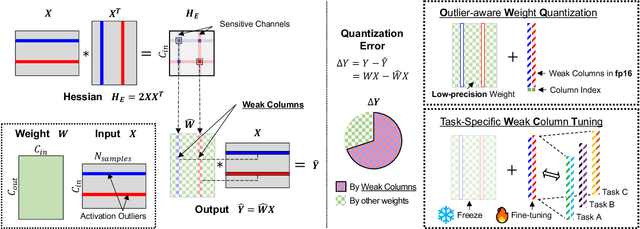

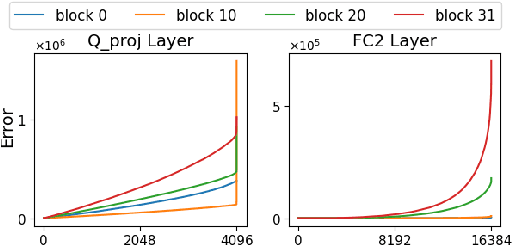
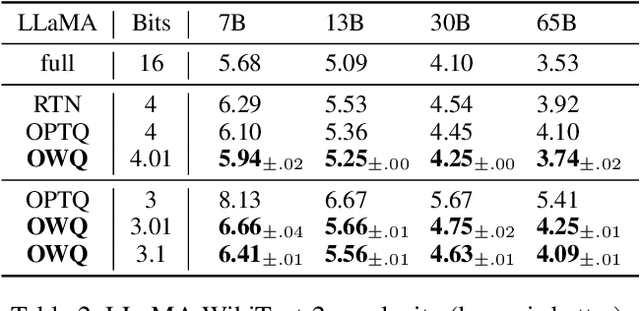
Abstract:Large language models (LLMs) with hundreds of billions of parameters show impressive results across various language tasks using simple prompt tuning and few-shot examples, without the need for task-specific fine-tuning. However, their enormous size requires multiple server-grade GPUs even for inference, creating a significant cost barrier. To address this limitation, we introduce a novel post-training quantization method for weights with minimal quality degradation. While activation outliers are known to be problematic in activation quantization, our theoretical analysis suggests that we can identify factors contributing to weight quantization errors by considering activation outliers. We propose an innovative PTQ scheme called outlier-aware weight quantization (OWQ), which identifies vulnerable weights and allocates high-precision to them. Our extensive experiments demonstrate that the 3.01-bit models produced by OWQ exhibit comparable quality to the 4-bit models generated by OPTQ.
Temporal Dynamic Quantization for Diffusion Models
Jun 04, 2023Abstract:The diffusion model has gained popularity in vision applications due to its remarkable generative performance and versatility. However, high storage and computation demands, resulting from the model size and iterative generation, hinder its use on mobile devices. Existing quantization techniques struggle to maintain performance even in 8-bit precision due to the diffusion model's unique property of temporal variation in activation. We introduce a novel quantization method that dynamically adjusts the quantization interval based on time step information, significantly improving output quality. Unlike conventional dynamic quantization techniques, our approach has no computational overhead during inference and is compatible with both post-training quantization (PTQ) and quantization-aware training (QAT). Our extensive experiments demonstrate substantial improvements in output quality with the quantized diffusion model across various datasets.
INSTA-BNN: Binary Neural Network with INSTAnce-aware Threshold
Apr 18, 2022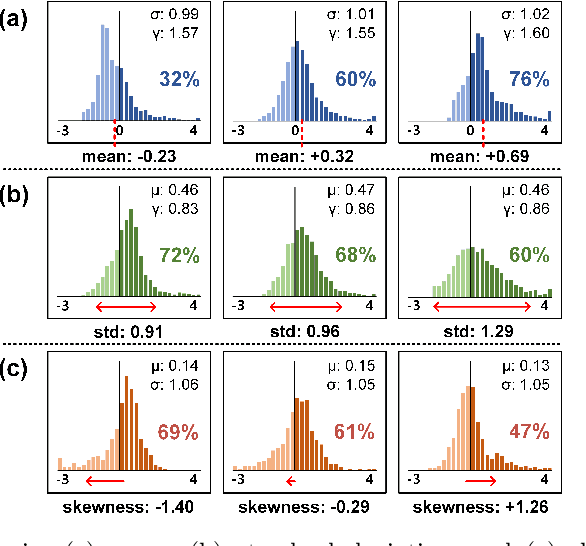
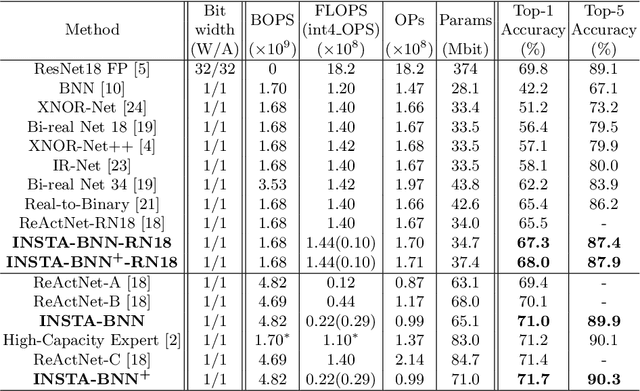
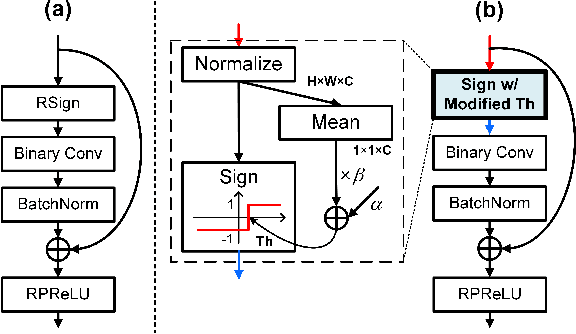
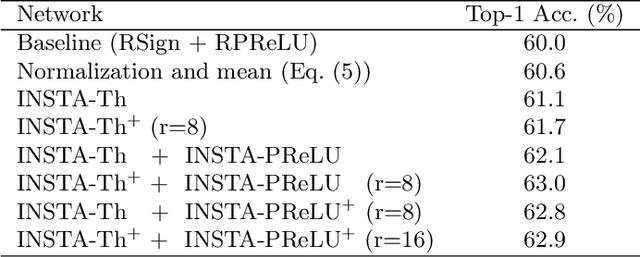
Abstract:Binary Neural Networks (BNNs) have emerged as a promising solution for reducing the memory footprint and compute costs of deep neural networks. BNNs, on the other hand, suffer from information loss because binary activations are limited to only two values, resulting in reduced accuracy. To improve the accuracy, previous studies have attempted to control the distribution of binary activation by manually shifting the threshold of the activation function or making the shift amount trainable. During the process, they usually depended on statistical information computed from a batch. We argue that using statistical data from a batch fails to capture the crucial information for each input instance in BNN computations, and the differences between statistical information computed from each instance need to be considered when determining the binary activation threshold of each instance. Based on the concept, we propose the Binary Neural Network with INSTAnce-aware threshold (INSTA-BNN), which decides the activation threshold value considering the difference between statistical data computed from a batch and each instance. The proposed INSTA-BNN outperforms the baseline by 2.5% and 2.3% on the ImageNet classification task with comparable computing cost, achieving 68.0% and 71.7% top-1 accuracy on ResNet-18 and MobileNetV1 based models, respectively.
Improving Accuracy of Binary Neural Networks using Unbalanced Activation Distribution
Dec 02, 2020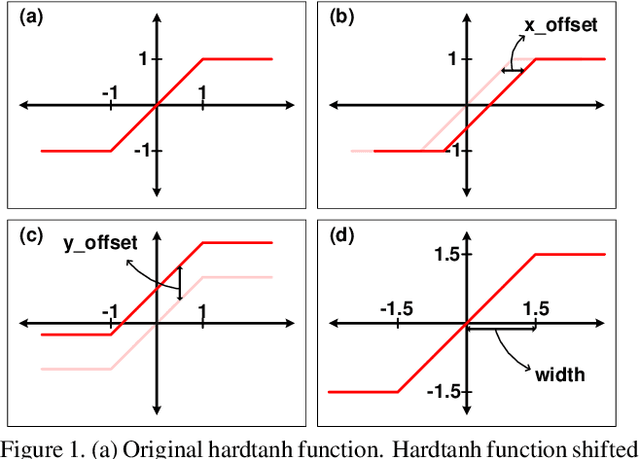

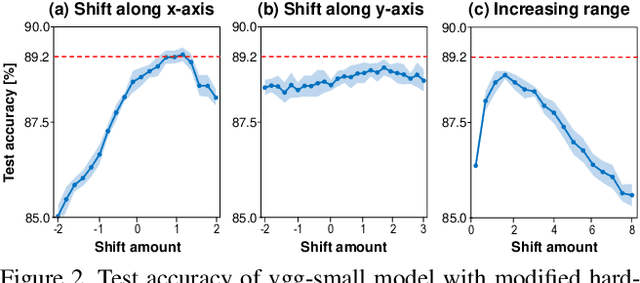
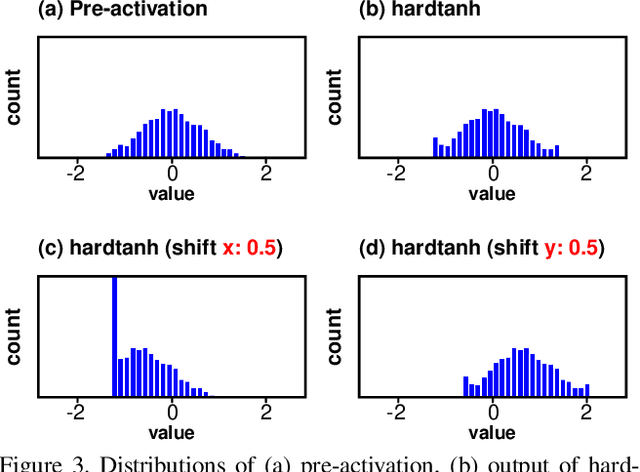
Abstract:Binarization of neural network models is considered as one of the promising methods to deploy deep neural network models on resource-constrained environments such as mobile devices. However, Binary Neural Networks (BNNs) tend to suffer from severe accuracy degradation compared to the full-precision counterpart model. Several techniques were proposed to improve the accuracy of BNNs. One of the approaches is to balance the distribution of binary activations so that the amount of information in the binary activations becomes maximum. Based on extensive analysis, in stark contrast to previous work, we argue that unbalanced activation distribution can actually improve the accuracy of BNNs. We also show that adjusting the threshold values of binary activation functions results in the unbalanced distribution of the binary activation, which increases the accuracy of BNN models. Experimental results show that the accuracy of previous BNN models (e.g. XNOR-Net and Bi-Real-Net) can be improved by simply shifting the threshold values of binary activation functions without requiring any other modification.
Empirical Strategy for Stretching Probability Distribution in Neural-network-based Regression
Sep 08, 2020



Abstract:In regression analysis under artificial neural networks, the prediction performance depends on determining the appropriate weights between layers. As randomly initialized weights are updated during back-propagation using the gradient descent procedure under a given loss function, the loss function structure can affect the performance significantly. In this study, we considered the distribution error, i.e., the inconsistency of two distributions (those of the predicted values and label), as the prediction error, and proposed weighted empirical stretching (WES) as a novel loss function to increase the overlap area of the two distributions. The function depends on the distribution of a given label, thus, it is applicable to any distribution shape. Moreover, it contains a scaling hyperparameter such that the appropriate parameter value maximizes the common section of the two distributions. To test the function capability, we generated ideal distributed curves (unimodal, skewed unimodal, bimodal, and skewed bimodal) as the labels, and used the Fourier-extracted input data from the curves under a feedforward neural network. In general, WES outperformed loss functions in wide use, and the performance was robust to the various noise levels. The improved results in RMSE for the extreme domain (i.e., both tail regions of the distribution) are expected to be utilized for prediction of abnormal events in non-linear complex systems such as natural disaster and financial crisis.
 Add to Chrome
Add to Chrome Add to Firefox
Add to Firefox Add to Edge
Add to Edge